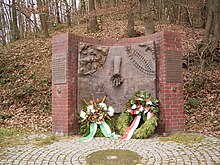Kemna concentration camp
The Kemna concentration camp was an early concentration camp in the Kemna district of Wuppertal between Beyenburg and Oberbarmen .
history
The concentration camp existed from July 1933 to January 19, 1934 and was operated by the Düsseldorf SA subgroup and the Wuppertal police chief Willi Veller with the support of the Düsseldorf district government . For a short time, the commandant of the concentration camp was SA Storm Leader Hugo Neuhoff . He was soon replaced by Alfred Hilgers, who was born in Wuppertal and, as the personnel manager of the staff of the SA subgroup Düsseldorf, also headed SA Standarte 258 in the Koburg protective detention center in Mettmann . The SA guards crammed up to 1,100 prisoners under catastrophic hygienic conditions in a former cleaning wool factory on Beyenburger Strasse directly on the Wupperufer . Torture and arbitrary violence were common. The number of prisoners during the seven months of this concentration camp is estimated at between 2,500 and 3,000.
So-called political prisoners from the ranks of the KPD and the SPD from the Bergisches Land were primarily arrested . Transports and lone prisoners also came from the cities of Duisburg , Düsseldorf , Krefeld and Essen, which belong to the administrative district .
While the guards in many other concentration camps were made up of different parts of Germany, Kemna was a peculiarity in this regard: inmates and guards often knew each other personally, as the guards of the Kemna concentration camp consisted of parts of the local SA.
Remember the victims
To mark the 50th anniversary of the facility, a memorial ( 51 ° 15 ′ 20.8 ″ N , 7 ° 15 ′ 19.3 ″ E ) was erected opposite the factory site in 1983 , at which a wreath-laying ceremony is held every year by members of the Wuppertal Youth Ring . Which was designed bronze - relief by Art Association of the Wuppertal school at Kothen . The path leading to the memorial has been named after the youngest Kemna prisoner Karl Ibach since 1990 .
In the past, the memorial was vandalized several times by rioters from the right-wing extremist area, among other things protruding parts were sawed off. The damage was repaired immediately, the perpetrators identified and criminally prosecuted.
A memorial path marked with wooden signs leads from Langerfelder Markt to the memorial. It was set up in autumn 2001 by the Wuppertal youth welfare service in cooperation with several municipal secondary schools.
In the summer of 2005, the history of the Kemnas concentration camp was documented in detail at an exhibition in the Wülfing Museum in Radevormwald . This part of the exhibition focused on the biographies of the victims from Radevormwald, Wermelskirchen and Hückeswagen .
In Radevormwald, memorial plaques with the names of 16 victims remind of the 200 or so Rader citizens who suffered in 1933 in the Kemna concentration camp.
In 2019, the General Association of Protestant Congregations in the Wuppertal Church District acquired the remains of the former concentration camp. There are plans to set up a memorial site and a new archive for the Wuppertal church district.
Known inmates
- Wilhelm Bökenkreger
- Heinrich Hirtsiefer
- Oskar Hoffmann
- Karl Ibach
- Max Leven
- Heinz Kiwitz
- Friedrich Senger
- Günther Strupp
See also
literature
- Karl Ibach: Kemna. Wuppertal concentration camp 1933–1934 . Reprint of the first edition in 1948. Wuppertal 1981, ISBN 3-87294-173-9 .
- Klaus Drobich et al .: System of the Nazi concentration camps 1933–1939 . Berlin 1993, ISBN 3-05-000823-7 .
- David Magnus Mintert: The early Kemna concentration camp and the socialist milieu in the Bergisches Land (PDF; 6.6 MB), dissertation, Ruhr-Universität Bochum 2007.
- David Magnus Mintert: Insulted, dirty and beaten night after night. The Wuppertal SA concentration camp Kemna 1933/34 . in: Jan Erik Schulte (ed.): Concentration camps in the Rhineland and Westphalia 1933–1945. Central control and regional initiative. Paderborn 2005, ISBN 3-506-71743-X , pp. 33-48.
- Friedrich Brass: Kemna report 1933/34. Based on a handwritten version by the author from 1934. Commentary and remarks by David Magnus Mintert; Foreword by Ulrike Schrader . Ed. Old Synagogue Meeting Center , Wuppertal 2008, ISBN 978-3-940199-01-0 .
- Willi Weiler, Kurt Schnöring, Siegfried Wirtz, Wuppertal Youth Ring: Kemna. My experiences in the Wuppertal concentration camp. 1998, ISBN 978-3-87093-081-3 .
Audio CD
- David Magnus Mintert: “I can still hear the screams of the defeated.” 70 years of Kemna concentration camp . Bergische contemporary history. Audio documentation of a lecture, July 4, 2003
Web links
- KZ Kemna Website of the youth association Wuppertal
- Fritz Brass: Wuppertal's forgotten opponent of the Nazis , in Westdeutsche Zeitung , Newsline, from July 20, 2014, a guest article by Michael Okroy
- Friedrich Brass: A chronicler of horror , Westdeutsche Zeitung v. May 28, 2013, by Sonja Klein. About a public reading of the Kemna report by Jörg Reimers
- Kemna concentration camp in the Wuppertal memorial book
Individual evidence
- ^ Karl Ibach: Kemna - Wuppertal camp of the SA. 1933 , Ed. Board of Directors of VVN Wuppertal (August 1948), p. 16.
- ↑ David Magnus Mintert: The early Kemna concentration camp and the socialist milieu in the Bergisches Land (PDF; 6.6 MB), dissertation, Ruhr University Bochum 2007.
- ↑ Mintert states the maximum occupancy in his dissertation as 1,100 prisoners, the average in autumn as 700-800, p. 164, in the online count p. 170.
- ^ Karl Ibach: Kemna - Wuppertal camp of the SA. 1933 , Ed. Board of Directors of VVN Wuppertal (August 1948), p. 22.
- ^ Similar in Munich in the Dachau concentration camp and in Danzig
- ↑ Former Kemna concentration camp becomes a memorial site. January 10, 2020, accessed January 16, 2020 .
Coordinates: 51 ° 15 ′ 18.5 ″ N , 7 ° 15 ′ 19.6 ″ E

